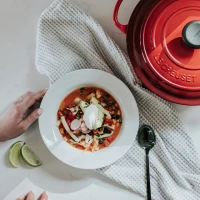As the popularity of vegetarianism continues to soar, the world of vegetarian cuisine has expanded to satisfy the diverse tastes and preferences of individuals around the globe. Gone are the days when vegetarian meals meant simply omitting meat from a dish. Today, vegetarian cooking is a vibrant and flavorful art that celebrates the abundance of plant-based ingredients and showcases their versatility.
In this article, we will explore the diverse world of vegetarian cuisine and share mouthwatering recipes that cater to every palate. Whether you are a dedicated vegetarian, looking to incorporate more plant-based meals into your diet, or simply curious about the flavors and possibilities of vegetarian cooking, this article will serve as your guide.
The Rise of Vegetarian Cuisine
Vegetarianism has gained immense popularity in recent years, driven by various factors such as health concerns, ethical considerations, and environmental consciousness. People are increasingly recognizing the benefits of a plant-based diet, not only for their own well-being but also for the planet isa brown hens.
Health Benefits of Vegetarianism
Numerous studies have shown that a well-balanced vegetarian diet can provide all the necessary nutrients and promote good health. By focusing on whole grains, legumes, fruits, vegetables, and nuts, vegetarians can enjoy a diet rich in fiber, vitamins, and minerals. This can lead to a reduced risk of chronic diseases such as heart disease, diabetes, and certain types of cancer.
Additionally, a vegetarian diet tends to be lower in saturated fat and cholesterol, which can contribute to better overall cardiovascular health. Plant-based proteins, such as those found in beans, lentils, and tofu, offer a healthy alternative to animal products while providing essential amino acids.
Ethical Considerations
For many individuals, vegetarianism is driven by ethical concerns regarding the treatment and exploitation of animals. By choosing a vegetarian lifestyle, people can actively participate in reducing animal suffering and promoting animal welfare. This ethical stance aligns with the belief in the inherent value of all living beings and the responsibility to minimize harm to animals.
Environmental Impact
The environmental impact of meat production is a growing concern for many people. Livestock farming, particularly intensive animal agriculture, contributes significantly to deforestation, greenhouse gas emissions, water pollution, and biodiversity loss. By adopting a vegetarian diet, individuals can significantly reduce their carbon footprint and help mitigate the negative consequences of meat production on the environment.
Exploring Vegetarian Ingredients
One of the joys of vegetarian cuisine is the sheer variety of ingredients available. From vibrant vegetables to hearty grains, legumes, and spices, vegetarian cooking offers endless possibilities to create delicious and satisfying meals. Let’s take a closer look at some of the key ingredients commonly used in vegetarian cuisine.
Vegetables
Vegetables are the cornerstone of vegetarian cooking, offering a multitude of flavors, textures, and nutrients. From leafy greens like spinach and kale to cruciferous vegetables such as broccoli and cauliflower, the world of vegetables is vast and diverse. Incorporating a rainbow of vegetables into your meals ensures a balance of vitamins, minerals, and antioxidants.
Furthermore, vegetables can be prepared in numerous ways, including roasting, steaming, stir-frying, and grilling, allowing for endless culinary creativity. Whether you prefer the crispness of fresh salads or the comforting warmth of roasted vegetables, there is a vegetable dish to suit every taste.
Grains and Legumes
Grains and legumes are staple ingredients in vegetarian cuisine, offering essential nutrients and a hearty texture. Whole grains like quinoa, brown rice, and bulgur provide a good source of carbohydrates, fiber, and minerals. They can be cooked as side dishes or incorporated into salads, stews, and casseroles.
Legumes, such as chickpeas, lentils, and beans, are rich in plant-based proteins, fiber, and iron. They form the basis of many vegetarian dishes, including curries, soups, and salads. Legumes can be cooked from scratch or conveniently used from canned options for quick and easy meal preparation.
Tofu and Tempeh
Tofu, made from soybean curds, and tempeh, made from fermented soybeans, are popular protein sources in vegetarian cuisine. These versatile ingredients absorb flavors well and can be cooked in various ways, from grilling and stir-frying to baking and marinating. Tofu and tempeh offer a delicate yet substantial texture, making them suitable substitutes for meat in many dishes.
Dairy and Dairy Alternatives
For lacto-vegetarians who consume dairy products, cheese, milk, and yogurt provide a rich source of calcium and protein. These dairy products can be used to add creaminess, tang, and depth of flavor to vegetarian dishes. From shredded cheese on a pizza to a dollop of yogurt in curries, the possibilities are endless.
For individuals following a vegan diet or those who prefer dairy alternatives, there is a growing range of plant-based milk, cheese, and yogurt made from ingredients such as soy, almonds, and oats. These alternatives offer a cruelty-free option while still providing the creamy textures and flavors associated with dairy.
Mouthwatering Vegetarian Recipes
Now that we have explored the world of vegetarian cuisine and its diverse ingredients, let’s delve into some mouthwatering recipes that showcase the exciting flavors and possibilities of vegetarian cooking. Whether you are a seasoned vegetarian or new to this culinary realm, these recipes are sure to tantalize your taste buds.
Recipe 1: Mediterranean Stuffed Bell Peppers
Ingredients:
- 4 bell peppers (any color)
- 1 cup cooked quinoa
- 1 cup cherry tomatoes, halved
- 1 cup crumbled feta cheese (or dairy-free alternative)
- 1/2 cup diced cucumber
- 1/4 cup chopped Kalamata olives
- 2 tablespoons chopped fresh parsley
- 1 tablespoon lemon juice
- 2 tablespoons olive oil
- Salt and pepper to taste
Instructions:
- Preheat the oven to 375°F (190°C). Cut the tops off the bell peppers and remove the seeds and membranes.
- In a mixing bowl, combine the cooked quinoa, cherry tomatoes, feta cheese, cucumber, Kalamata olives, parsley, lemon juice, olive oil, salt, and pepper. Mix well.
- Stuff the bell peppers with the quinoa mixture and place them in a baking dish.
- Bake for 25-30 minutes or until the peppers are tender and slightly charred.
- Serve hot and garnish with additional parsley if desired.
Recipe 2: Thai Green Curry with Tofu and Vegetables
Ingredients:
- 1 tablespoon vegetable oil
- 1 small onion, thinly sliced
- 2 cloves garlic, minced
- 2 tablespoons green curry paste
- 1 can (14 ounces) coconut milk
- 1 cup vegetable broth
- 8 ounces firm tofu, cubed
- 2 cups mixed vegetables (such as bell peppers, broccoli, and carrots)
- 1 tablespoon soy sauce
- 1 tablespoon brown sugar
- Fresh basil leaves for garnish
- Cooked rice for serving
Instructions:
- Heat the vegetable oil in a large skillet or wok over medium heat. Add the sliced onion and minced garlic, and sauté until softened.
- Stir in the green curry paste and cook for 1-2 minutes to release its flavors.
- Pour in the coconut milk and vegetable broth. Bring to a simmer.
- Add the cubed tofu and mixed vegetables to the skillet. Stir in the soy sauce and brown sugar.
- Simmer for 10-15 minutes, or until the vegetables are tender and the flavors have melded together.
- Serve the curry over cooked rice and garnish with fresh basil leaves.
Recipe 3: Lentil and Mushroom Shepherd’s Pie
Ingredients:
- 2 cups cooked lentils
- 1 onion, diced
- 2 cloves garlic, minced
- 8 ounces mushrooms, sliced
- 1 cup frozen peas
- 1 cup vegetable broth
- 2 tablespoons tomato paste
- 1 tablespoon Worcestershire sauce (optional)
- 2 tablespoons butter (or vegan butter)
- 4 cups mashed potatoes
- Salt and pepper to taste
Instructions:
- Preheat the oven to 375°F (190°C). In a large skillet, heat a tablespoon of oil over medium heat. Add the diced onion and minced garlic, and sauté until fragrant and translucent.
- Add the sliced mushrooms and cook until they release their juices and start to brown.
- Stir in the cooked lentils, frozen peas, vegetable broth, tomato paste, Worcestershire sauce (if using), salt, and pepper. Simmer for 10 minutes, until the mixture thickens slightly.
- Transfer the lentil and mushroom mixture to a baking dish and spread it evenly.
- In a separate bowl, combine the mashed potatoes and butter. Spread the mashed potatoes over the lentil mixture, creating a top layer.
- Bake for 30 minutes or until the mashed potatoes are golden and slightly crispy on top.
- Serve hot and enjoy the comforting flavors of this vegetarian Shepherd’s Pie.
These recipes are just a taste of the incredible variety that vegetarian cuisine offers. Whether you prefer Mediterranean flavors, spicy Thai dishes, or comforting classics, there are endless possibilities to explore and savor.
Conclusion
The world of vegetarian cuisine is a delightfully diverse and flavorful realm that caters to every palate. From health-conscious individuals to ethical vegetarians and environmentally conscious consumers, there are compelling reasons to embrace plant-based cooking. By exploring the myriad of vegetarian ingredients and trying out mouthwatering recipes, you can embark on a culinary journey that celebrates the abundance of plant-based options while indulging in delectable flavors.
Remember to prioritize fresh, seasonal ingredients, experiment with herbs and spices, and unleash your creativity in the kitchen. Vegetarian cuisine is a vibrant tapestry waiting to be explored, and by taking that first bite, you open a door to a world of delightful flavors and endless possibilities. So dive in, grab your apron, and let the tantalizing aromas of vegetarian cooking fill your home and your plate.










